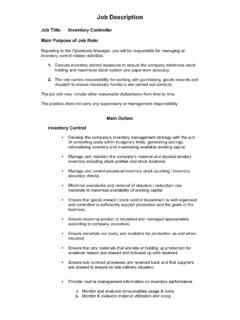Transcription of The Hay System of Job Evaluation: A Critical Analysis
1 Journal of Human Resources Management and Labor Studies June 2015, Vol. 3, No. 1, pp. 1-22 ISSN: 2333-6390(Print), 2333-6404(Online) Copyright The Author(s). 2015. All Rights Reserved. Published by American Research Institute for Policy Development DOI: URL: The Hay System of Job Evaluation: A Critical Analysis Muhammad Ali EL-Hajji1 Abstract This paper provides an overall insight of the Hay System of job evaluation (Guide Chart Profile Method). It answers the question of Hay s thinking behind his purpose to develop an alternative (and in his view) more effective System for measuring and assessing jobs (particularly the more senior management and executive posts).
2 The paper also provides an analytical view demonstrating how Hay constructed his System to given parameters within given structure and shows that its specific composition lies in what he termed his three primary factors . Hay s thinking and his work experience underpinned the foundations upon which the design and the construction of this System were formed. Hence, this paper illustrates not only the Hay System in general terms but also why he attached importance to each of its basic components such as job factors, his allocation of weightings, the importance of contribution made by each factor, his model for assigning given points to each factor and the degree of flexibility attached to his System .
3 Moreover, the paper compares and contrasts the Hay System with other models of job evaluation. The paper also answers the question of what made the Hay System popular to the point of global recognition whilst simultaneously attracting its critics. Our academic experience of teaching for more than two decades with a further decade in both education and the business sector is the bedrock upon which this work is constituted. Keywords: Hay System , Design, Composition & Construction, Mechanism, Recognization, Differences from Other Systems, Shortcomings General Introduction Dr Edward N.
4 Hay (1891-1958), (see , Note 1) an authority on the subject of Job Evaluation, confronted the generally accepted approach of using the point method scales, when determining job factors in relation to relative job worth. 1 PhD Business Administration, Assistant professor, Department of management and Marketing, University of Bahrain, Kingdom of Bahrain. Email: Mobile; 00973: 350 954 81 2 Journal of Human Resources Management and Labor Studies, Vol. 3(1), June 2015 He maintained that, in practice, this original approach did not show or represent regular intervals or uniform/constant increments between the successive levels (of difficulty) for each job factor.
5 Thus he explained that the irregularity of the intervals or increments mean that the scales produced on the point method are not representative of either erythematic multiplication or geometrical progress. (See , Note 2). In his article characteristics of factor comparison job evaluation , (Hay (1), 1946), Hay had expressly shown his confidence and belief in the judgement of the skilled and well trained evaluators to present/produce equal intervals; usually geometrically increased, from lower to higher jobs. In this way, Hay tries to apply Weber s Law to the establishment of degrees.
6 Weber s law refers to the phenomenon of a geometric increase in value of the factor comparison scales from step to step; firstly identified by Weber; see also Otis & Leukar (1948). Yet Hay has nowhere expounded a theoretical basis of the geometric progression for the job factors in the guide chart - profile method [Professor T. T. Paterson (1972: 109). Nonetheless, these intervals generally reflect the existing salary structure of the organization concerned. Hay(2), in his article setting salary for executive jobs (1958: 64), believed that point plans are shown to be ineffective when they have been applied to the rating of high level managerial and technical jobs.]
7 For him, the point plan ( System ) is just unsuitable for evaluating top management jobs for they are either too complex or a product of the principle that it is the man (who) makes the job . In other words, Hay s view is that, the point plan was not primarily designed to measure or assess high managerial positions and thus it does not employ management thinking . (Contrary to this view see , Note 3). It should be recognised that a second System , the factor comparison method, was born out of the point method and the Hay method has been drawn from the womb of both the point method of 1924 and the factor comparison method of 1926 this, after so many experiments and applications of both of these systems (see , Note 4, for other interchangeable names for each of these two methods).
8 It took Hay and his work associates some 25 years to develop this alternative method, in its final form, that continues to carry his name through to the present day. At the time there was a pressing need for a new System or method to measure high level managerial and technical jobs (executive positions). Muhammad Ali EL-Hajji 3 This required different responses to management thinking and an ability to measure high level managerial and technical jobs (executive positions). In 1951 (and in response to the demand of the Owens Illinois Company-USA) Hay and his colleague (Dale Purves), developed a new plan or scheme called the Guide Chart profile Method.
9 At this point it is pertinent to pass comment on the term scales (mentioned above and also referred to as factor scales . In having the compensable factors decided or chosen, each factor can be further divided into sub factors and degrees. The scales are formulated or shaped through determining the differences between each degree and then again separately within each related sub-factor. These differences or intervals for each degree are defined as being equidistant from the immediate adjacent degree. (See also Sec. 9, Note 5). Design and Development of the Guide Chart Profile Method The guide chart profile method is a combination of two methods; the Profile Method and the Guide Chart Method.)
10 The profile method was designed and developed by Dale Purves, grown out of the Per Cent Method, which in turn, was a modification of the factor comparison method. Thus, to date, the profile method represents the final version of an emergent product that has evolved out of the other two. It employs and is specific to the three broad elements (primary factors) of any given job. These are the Know-how, Problem-solving, and Accountability. With this method, Purves applied the idea of combining several scales on one sheet or one chart as a means of objectively describing the step and point values of the profile method.












